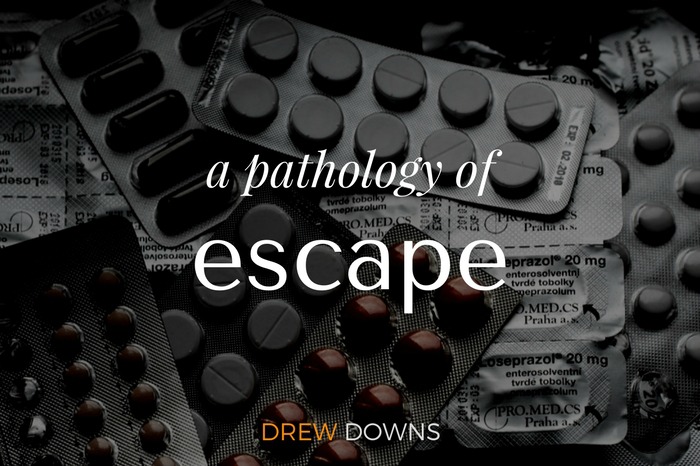In a challenging new essay for Eudaimonia & Co., Umair Haque names 5 social pathologies of collapse. And I think they can kickstart a conversation around our culture’s greatest needs. This is my reflection of the second pathology: the opioid epidemic.
When I left my small-town high school for college, two things rocked my world.
The first was the real prevalence of divorce and remarriage. It seemed as if all my friends were the product of divorce. What I had taken for granted: that having two parents happily married to each other in their first marriage was the norm: was destroyed quickly.
I suddenly felt like I was a member of an extreme minority.
I also discovered how many of my friends were in therapy. The small town expectations, that we “man up” and “bottle” our emotions, became so ridiculous against the backdrop of pervasive emotional pain.
I found that the cultural norms I grew up with weren’t idyllic. They were repressive. The lives of my peers back home were just as messed up as the lives of my college friends. The only difference was how open we were about them in college.
Drugs, alcohol, divorce, abuse were all going on back home. That was before we had an opioid epidemic. But the seeds were definitely there.
A Distraction
A regular point of conversation I have with my best friend is the subject of distraction.
We’ve both given up and returned to video games throughout our lives. Every time we’ve given them up, it’s because they were getting in the way.
But really, it’s more than that.
We use them to distract ourselves. Escape.
The recent classification of video game addiction as a disorder by the World Health Organization confirms our own diagnosis.
It is this need to escape which controls so much of our thinking and decision-making; and what we regularly hide behind bravado and boot-strapping.
We can’t admit it’s at the heart of our decisions, so we refuse to tackle it directly.
Killing Ourselves
When exploring the uniquely American problem of school shootings, we started digging into the deep need behind them. A need which manifests in violence. But not only violence.
“Still, what do the kids who aren’t killing each other do? Well, a lot of them are busy killing themselves.”
The world-high suicide rate is one marker. The other is world-high rate of overdoses.
But the end (death) isn’t the only concern for us in dealing with the means (guns/drugs). We must also wrestle with the “why” behind it.
And this leads us to opioids.
“So there is of course also an “opioid epidemic”. We use that phrase too casually, but it much more troubling than it appears on first glance.”
Much like the school shooting epidemic, the opioid epidemic is easily labeled and discussed with crisis language, but not crisis action. Action which needs to wrestle with why.
“In many countries in the world — most of Asia and Africa — one can buy all the opioids one wants from any local pharmacy, without a prescription. You might suppose then that opioid abuse as a mass epidemic would be a global phenomenon. Yet we don’t see opioid epidemics anywhere but America — especially not ones so vicious and widespread they shrink life expectancy. So the “opioid epidemic” — mass self-medication with the hardest of hard drugs — is again a social pathology of collapse: unique to American life. It is not quite captured in the numbers, but only through comparison — and when we see it in global perspective, we get a sense of just how singularly troubled American life really is.”
The opioid epidemic, this singularly American phenomenon, like school shootings, begins with action. But it must go deeper than that.
“Why would people abuse opioids en masse unlike anywhere else in the world? They must be living genuinely traumatic and desperate lives, in which there is little healthcare, so they have to self-medicate the terror away. But what is so desperate about them? Well, consider another example: the “nomadic retirees”. They live in their cars. They go from place to place, season after season, chasing whatever low-wage work they can find — spring, an Amazon warehouse, Christmas, Walmart.”
Behind the Opioid Epidemic
It’s too easy to blame dysfunction on disease, shooters on madness, addiction on weakness. Like all the excuses we give for doing nothing, the reasons to hate the addict are always within reach.
Just like it’s easier to show sympathy for the opioid addict in Jeffersonville, Indiana than Los Angeles, California, it’s far easier to show sympathy for the opioid addict in 2018 than a crack addict in 1980s.
It’s easy to blame the symptoms because we don’t want to actually wrestle with what is causing the disease.
Going at the opioid epidemic like it’s born of human weakness is social malpractice. Pretending it isn’t born of the complex societal factors of culture and class is literally killing people.
The life people are living is leading them to escapism.
And if what we want is for people to live full, vibrant lives, then escapism is its tempter and destroyer.
How can we pretend the hell millions of people are living in is unconnected? That it’s all of their own making?
When do we stop shifting our focus on the hell people are living in to the judgment of why they’re living there? The better question is how did they get stuck there? Why aren’t we rescuing them? And why aren’t we breaking down hell and reducing it to rubble?
Why is the United States the only country so willing to let its neighbors rot in the hell of our communal making?

